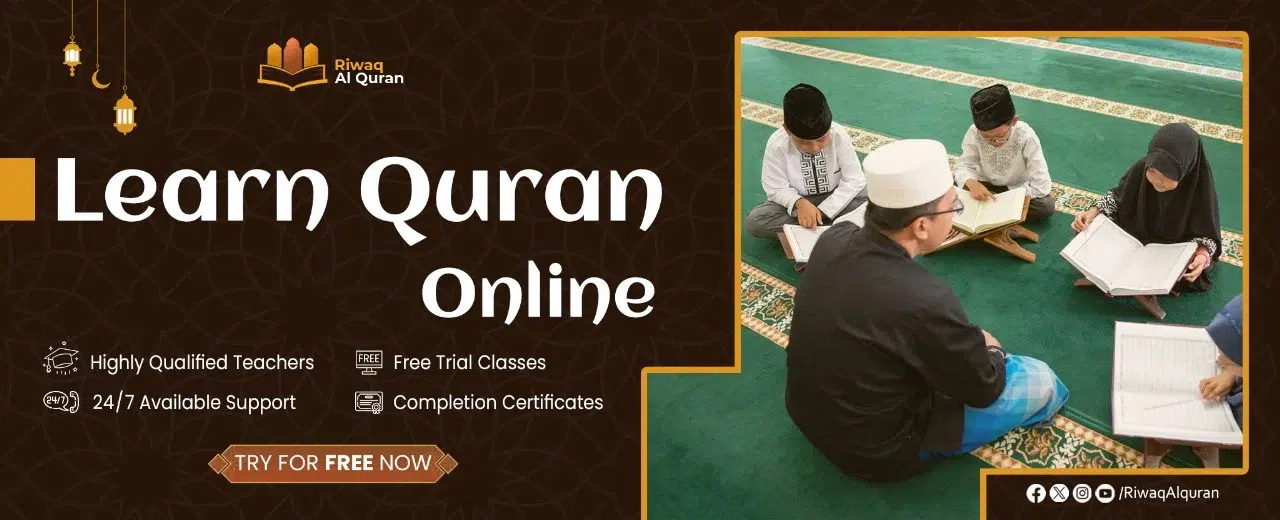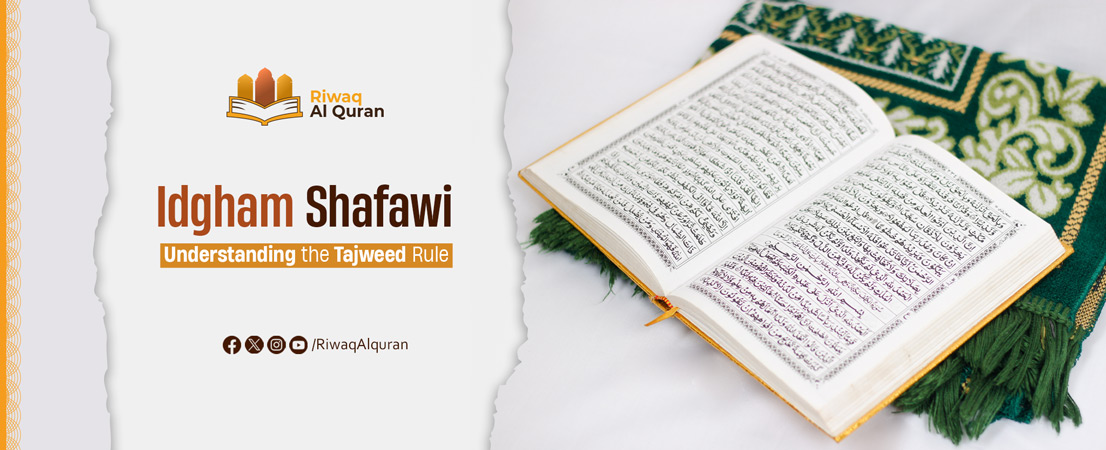In Tajweed [the art of reciting the Quran with proper pronunciation], Idgham is one of the rules of Noon Sakinah, Tanween, and Meem Sakinah. Idgham is to combine two sounds into one sound, making a shada (ّ) [double sound]. One of the types of Idgham is Idgham Shafawi. It has to do with Meem Sakinah only. In this article, we will examine Idgham Shafawi in more detail.
Below we will explore the meaning of Idgham Shafawi. We will also tackle the Idgham Shafawi rule which includes Ghunnah ruling, how Idgham Shafawi is pronounced, why it is called Shafawi, and the sign of Idgham Shafawi in the Quran. Then, we will examine Idgham Shafawi types along with some examples, both from everyday spoken language and the Quran.
Table of Contents
What Is Idgham Shafawi?
Idgham Shafawi is one type of Idgham, that deals with Meem Sakinah only. It occurs when Meem Mutaharika follows Meem Sakinah. Both Meem sounds are merged (that’s why it is called Idgham) and become one stressed Meem (one Meem with Shada [ّ]).
Idgham Shafawi Rule
Idgham Shafawi occurs when a Meem sound follows another Meem sound. The first must be Sakinah [with no sign above or under it] and the second must be Mutaharika [with a Fatha (َ), Kasra (ِ), or Damma (ُ)]. So Idgham Shafawi is implemented when one letter only follows Meem Sakinah: Meem Mutaharika.
Now, let’s see the ruling of Ghunnah in Idgham Shafawi, how Idgham Shafawi is pronounced, why it is called “Shafawi”, and its sign in the Quran [the written text].
Ghunnah Ruling
Ghunnah is a nasal sound that is produced when the sound of the letter Noon (ن) or the letter Meem (م) is done from the nose for approximately two seconds [i.e. 2 Harakat (one Haraka is equal to one finger count)]. In Idgham Shafawi, there is a complete Ghunnah that lasts for two Harakat.
How Is Idgham Shafawi Pronounced?
When Idgham Shafawi is implemented, both lips should be completely closed together, accompanied by a complete Ghunnah that takes two Harakat.
Why Is It Called Shafawi?
This kind of Idgham is called Shafawi (from the lips), because the place of articulation of the Arabic letter “Meem” (م) is the lips. Since it is produced by uttering one stressed Meem sound, it is called Shafawi (by the lips).
Sign Of Idgham Shafawi In The Quran:
When Idgham Shafawi ruling is to be implemented in the Quran, the Meem Sakinah has no sign above or under it, and the Meem Mutaharika has the sign of Shada [ّ] above it. See for example:
“لَهُم مَّا يَشَآءُونَ فِيهَا”
Here, it is clear that the Meem Sakinah (the last letter in the word “لَهُم”) has no sign above or under it, and there is a sign of Shada [ّ] above the Meem Mutaharika (the first letter in the word “ما”).


Idgham Shafawi Types
There are no specific types of Idgham Shafawi. However, it can be sub-categorized into Idgham Shafawi in one word and Idgham Shafawi in two words. Let’s explore these two types with examples.
1. Idgham Shafawi In One Word:
In this type of Idgham Shafawi, both Meem Sakinah and Meem Mutaharika sounds occur together in the same word. We stress here the fact that they are sounds, and not necessarily letters, as the ruling has to do with spoken rather than written text. This is explained in the following example.
“الٓمٓر“
Here, the Meem sound at the end of “Lam” letter (ل) is Sakinah [Meem Sakinah here is only a sound and not a letter], and it is followed by Meem Mutaharika (م) [Meem Mutahreka here is both a sound and a letter]. So Idgham Shafawi is implemented and they are merged into one stressed Meem.
2. Idgham Shafawi In Two Words:
In this type of Idgham Shafawi, Meem Sakinah and Meem Mutaharika occur in two different consecutive words, where the first word ends with Meem Sakinah and the second one starts with Meem Mutaharika. For example:
“وَءَامَنَهُم مِّنْ خَوْفٍۭ”
Here, the Meem sound at the end of “آمنهم” is Sakinah, and is followed by Meem Mutaharika (م) in “من”. So they are merged into one stressed Meem, produced by the lips and a complete Ghunnah is kept.
3. Idgham Shafawi Examples
Idgham Shafawi ruling is very common in both everyday spoken language and the Quran. Let’s see some examples of these.
Read more about: Idgham With Ghunnah And Idgham without Ghunnah
Experience Riwaq Al Quran Classes
Watch real moments from our live sessions at Riwaq Al Quran and see how we bring learning to life. These clips highlight our interactive, student-focused approach designed to keep learners engaged, motivated, and actively involved in every step of their educational journey.
Examples of Idgham Shafawi From The Quran:
Also in the Quran, the Idgham Shafawi ruling is recurrent, and as one of the Tajweed rules, must be implemented. Let’s see the following two examples.
“وَمِنْهُم مَّن يُؤْمِنُ بِهِۦ وَمِنْهُم مَّن لَّا يُؤْمِنُ بِهِ”
“تِلْكَ أُمَّةٌۭ قَدْ خَلَتْ ۖ لَهَا مَا كَسَبَتْ وَلَكُم مَّا كَسَبْتُمْ”
In these two examples, we can also see that Meem Sakinah (the last letter in the words “منهم” and “لكم”, respectively) is followed by Meem Mutaharika (the first letter in the words “من” and “ما”, respectively). So Idgham Shafawi ruling needs to be implemented as explained before.
Examples From Everyday Spoken Language:
In the spoken Arabic language, there are many applications of the Idgham Shafawi ruling. Let’s see the following two examples.
“جئتكم من عند خير الناس”
“شربتم من الماء”
In those two examples, we can clearly see that Meem Sakinah (the last letter in the words “جئتكم” and “شربتم”, in turn) is followed by Meem Mutaharika (the first letter in the word “من” in both cases). So, here, Idgham Shafawi ruling must be implemented: Both Meem sounds are merged into one stressed Meem while keeping a complete Ghunnah.
Read more about: Idgham Kamil Vs Idgham Naqis


Why Students Love Learning with Riwaq Al Quran
Hear directly from our students about how Riwaq Al Quran Academy has transformed their connection with the Book of Allah. Their experiences reflect the dedication, care, and quality that guide every step of our teaching.
Learn Quran, Arabic And Islamic Studies Online With The Best Native Tutors
Riwaq Al Quran is a comprehensive online platform that offers personalized Quran, Arabic and Islamic Studies Online classes for individuals of all ages and backgrounds.
Their experienced instructors use a structured curriculum to cover Tajweed, Tafsir, and Memorization, providing easy and effective access to learning the Quran.
The advanced online classes allow for seamless communication and interaction between students and teachers. Join Riwaq Al Quran for a deeper connection with the Quran.
We offer several courses such as:
- Online courses for kids.
- Online Quran classes for kids and adults.
- Online Arabic courses
- Online Ijazah courses
- Online Islamic Studies courses.
Here are a sample of our set of Quran Courses that will be helpful for you:
- Online Tafseer Course: Delve into Quranic meanings with our insightful online Tafseer course.
- Noorani Qaida Online: Learn Quranic basics efficiently through our Noorani Qaida online program.
- Online Quran Recitation Course: Enhance Quranic recitation skills through our expert-led online course.
- Online Tajweed Classes: Master Tajweed rules for beautiful Quranic recitation in online classes.
- Quran Memorization Online Course: Memorize the Quran effectively with our specialized online memorization course.
- Online Qirat Course: Explore diverse Qirat styles with our comprehensive online Qirat course.
- Online Quran Classes for Kids: Nurture a love for the Quran in kids through interactive online classes.
Conclusion
Idgham Shafwai, as a part of Idgham ruling in Tajweed, maintains phonetic correctness while enhancing the aesthetic quality of Quranic recitation. So it serves both a technical and artistic function in Tajweed.
Thus, understanding and applying Idgham Shafwai ensure the reciter adheres to the rules of Tajweed, while providing clarity, precision, and the preservation of the Quran’s intended meaning.
Also, this rule is so important for the proper articulation of the Quran and contributes to the fluid nature of the recitation. That’s because the general principle behind Idgham Shafwai [merging two similar sounds] creates a smoother, more fluid connection between the sounds, making the recitation more harmonious. So learning it is a must for all Quran reciters.


































